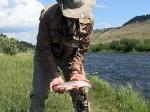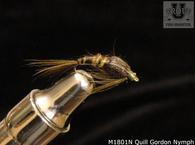
In this class the student will learn how the habitat differs for the various species as well as what other factors are involved in finding trout; such factors as suspended oxygen and temperatures.

Four minutes from where I sit in an office eight hours a day is a tiny stream that is my laboratory, escape valve, and forty-five-minute retreat. I can fish three or four pools on my lunch hour. In one favorite half-mile stretch I know virtually every fish except the unseen brown trout that I suspect inhabit a couple of deep undercut banks at the base of streamside maples. I have never caught one of these elusive browns, but I imagine them sulking in a tangle of drowned roots, oblivious to my flies but capable of eating a six-inch brook trout followed by a three-day fast. At the beginning of each season I mark a couple of gullible brook trout by clipping their adipose fins so I can follow their progress through the season. If I can figure out where they are living, I can almost always catch them. In early spring they are in the deeper, slower pools, and to catch them you need a large nymph fished close to the bottom, with no drag at all. As water temperatures rise above 55 degrees and flies start to hatch, they will be pulled from the pools into shallow riffles. Now a dry fly will work, as will a wet fly or nymph that swings across the current. As water levels fall during the summer, they can be hard to find, and whenever I fail to catch one that has been in the same spot for a couple of months, I start to imagine my brookie in an aluminumfoil coffin in somebody's freezer, or in the belly of a heron or otter. With the lower water levels it's also likely that there are fewer places in this little stream that can hold trout, and my friends were pushed downstream by more aggressive trout. In summer most of the trout are concentrated in only the deepest holes and in the heads of pools — it may be a hundred feet between places that hold trout.
During the winter and early in the season trout are more concerned with avoiding anchor ice and floods than they are with eating. There are few insects in the drift for them to capture, and their metabolisms are slowed to the point where they take little advantage of the food that might be available. Shallow water can be scoured by floating ice and anchor ice, which grows from the bottom of the river, so look for trout in deep-water refuges, out of the main current. When there is no ice, though, I have caught them on sunny days in shallow riffles, and because I doubt trout spend the winter in water like this, I suspect they move into places that are warmed by the sun as spring starts to wake up the river. As the water temperature approaches 50 degrees, and insects begin to drift and hatch, the fish migrate to shallow riffles and the heads of pools to take advantage of insect life at its source. You can gauge the migration time by the first major hatch of the season. In the East, if you blind-fish before the Hendrickson hatch, you'll find most trout in the side eddies and backwaters, but as soon as this first big hatch begins, the trout appear in riffles, in tails of pools, and out in the main current. They're still there on days when the flies don't hatch, and early in the morning on days when flies don't hatch until midafternoon.
There they will stay until low water and high temperatures shrink the comfortable places in a stream and concentrate the trout. As habitats contract, trout don't move far, sometimes just from one side of the pool to another, or from the middle to the head. In the tail of a big pool on the lower Battenkill, I found a pod of a half-dozen large brown trout one late spring evening, and I returned a couple of evenings a week to work them over. By the middle of the summer I had caught and released most of them, including a couple that I fin-clipped. A vacation kept me away from them for ten days, and when I returned the places where they had been feeding were almost dry. I couldn't find a single one. One night I happened to look at the other side of the river, which was deeper but had never produced a fish, I guess because this deeper pocket was out of the main current and did not supply enough food. There were several good fish rising there, and sure enough, over the next several weeks I caught some that I had clipped. As I looked carefully at the water, I saw that their new home was deep enough to keep them secure. The current had shifted because of a newly exposed gravel bar, and by the looks of the bubble line coming down through the pool, most of the food was now funneled to the opposite side of the river.

In the tough late season there are three keys to finding trout: temperature, oxygen, and flow. If you remember them, you will catch trout all day long, even in the noonday heat of August when there is slim chance of any kind of hatch.
Temperature: Look for springs entering the river. Even springs whose surface flow runs dry during the summer usually offer some flow below the dry channel, so a scar of clean rocks along the bank that looks as though it might have been a tributary in early spring may tip you off to some cooler water. In general any entering tributary will be cooler than the main river, so look for trout below the confluence of a smaller and a larger stream. Wade wet to find springs entering the river beneath the streambed.
Oxygen: Water's oxygen content is inversely related to its temperature, so if you can't find the cooler water, which holds more oxygen, look for places where oxygen is forced into the water by physical means. Riffles, runs, pocket water, the bases of dams — trout will move to these places in midsummer, often leaving the rest of a pool barren.
Flow: This important factor of midsummer trout fishing is often overlooked. Trout won't live where they can't eat, and during low water their options are limited, making stream reading easier. Especially in slower pools, don't look for trout anywhere but right under the bubble line, because flow is reduced to a point where only the main current offers enough food. If you can't locate the bubble line or it doesn't seem to help, another way of finding trout is to look at the stones on the bottom. Once when I was fishing a stream known for its wild rainbows, I was in a wide riffle that holds scores of trout during the spring, and I knew some of them had to be around, even though the water looked too shallow. At first the entire riffle looked daunting and I couldn't decide where to start. Then as I stared at the water, I noticed something. Most of the rocks on the bottom were covered with a thin film of dusty-looking silt, but in places that were slightly deeper and had a stronger current, the rocks had been wiped clean. That gave me some targets, and by pitching a Flashabou Caddis Larva into the narrow lanes of clean stones, I picked up a half-dozen ten-inch fish, more than I would have expected in such a flat, shallow riffle. Exerpts by Tom Rosenbauer
Review what has been learned in the previous class, Class 367 Prospecting for Trout in Springs and Banks. On your next fishing outing be aware of the temperature, the flow and the other characteristics that are given in this class.
Recommended DVDs:
Fly Fishing for Trout in Tailwaters
Fly Fishing Strategies That Catch Trout
Read the The Orvis Guide to Prospecting for Trout.
Class material has appeared in MidCurrents.





